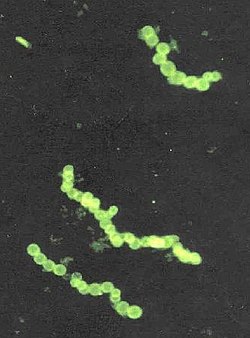Thiomargarita namibiensis
| Thiomargarita namibiensis | |
|---|---|

| |
| Stained microphoto of Thiomargarita namibiensis | |
| Scientific classification | |
| Kingdom: | |
| Phylum: | |
| Class: | Gamma Proteobacteria
|
| Order: | |
| Family: | |
| Genus: | Thiomargarita
|
| Species: | T. namibiensis
|
| Binomial name | |
| Thiomargarita namibiensis Schulz et al., 1999
| |
Thiomargarita namibiensis is a gram-negative coccoid Proteobacterium, found in the ocean sediments of the continental shelf of Namibia. It is the largest bacterium ever discovered, in general, 0.1–0.3 mm (100–300 μm) wide, but sometimes up to 0.75 mm (750 μm).[1][2] Its size is large enough to be seen by the naked eye.
The genus name originates from Greek θεῖον (theion) = sulfur (see Thio-), and Latin margarita = pearl. This is a reference to the fact that the bacterium-chains have the appearance of a thin string of pearls, due to microscopic sulfur granules inside the bacteria, reflecting the incident light. The species name namibiensis indicates its origins in coastal Namibia, meaning Sulfur pearl of Namibia.
Occurrence
The species was discovered by Heide N. Schulz and others in 1997, in the coastal seafloor sediments of Walvis Bay (Namibia). In 2005, a closely related strain was discovered in the Gulf of Mexico. There are no other species in the genus Thiomargarita.
The previously largest known bacterium was Epulopiscium fishelsoni, at 0.5 mm long.[3]

Thiomargarita namibiensis

Metabolism
The bacterium is chemolithotrophic, and is capable of using nitrate as the terminal electron acceptor in the electron transport chain. The organism will oxidize hydrogen sulfide (H2S) into elemental sulfur (S). This is deposited as granules in its cytoplasm and is highly refractile and opalescent, making the organism look like a pearl.
While the sulfide is available in the surrounding sediment, produced by other bacteria from dead microalgae that sank down to the sea bottom, the nitrate comes from the above seawater. Since the bacterium is sessile, and the concentration of available nitrate fluctuates considerably over time, it stores nitrate at high concentration (up to 800 millimolar[4]) in a large vacuole, like an inflated balloon, which is responsible for about 80% of its size.[5] When nitrate concentrations in the environment are low, the bacteria uses the contents of its vacuole for respiration. Thus, the presence of a central vacuole in its cells enables a prolonged survival in sulfidic sediments. The non-motility of Thiomargarita cells is compensated by its large cellular size.[6]
Recent research has also indicated that the bacteria may be facultatively anaerobic rather than obligately anaerobic, and thus capable of respiring with oxygen if it is plentiful.
Significance
Gigantism is usually a disadvantage for bacteria.[7] Bacteria obtain their nutrients via simple diffusion process across their cell-membrane, as they lack the sophisticated nutrient uptake mechanism found in eukaryotes. A large size of a bacterium would imply lower ratio of cell membrane's surface area to cell volume. This would limit the rate of uptake of nutrients to threshold levels.[8] Large bacteria might starve easily unless they have a different backup mechanism. T. namibiensis overcomes this problem by harboring large vacuoles that can be filled up with life-supporting nitrates to sustain its life.
References
- ^ "The largest Bacterium: Scientist discovers new bacterial life form off the African coast", Max Planck Institute for Marine Microbiology, 8 April 1999 [dead link]
- ^ List of Prokaryotic names with Standing in Nomenclature - Genus Thiomargarita
- ^ Randerson, James (8 June 2002), "Record Breaker", New Scientist
- ^ Schulz HN, Brinkhoff T, Ferdelman TG, Mariné MH, Teske A, Jorgensen BB (1999), "Dense populations of a giant sulfur bacterium in Namibian shelf sediments", Science, 284 (5413): 493–5, doi:10.1126/science.284.5413.493, PMID 10205058.
{{citation}}: Unknown parameter|month=ignored (help)CS1 maint: multiple names: authors list (link) - ^ Kalanetra KM, Joye SB, Sunseri NR, Nelson DC (2005), "Novel vacuolate sulfur bacteria from the Gulf of Mexico reproduce by reductive division in three dimensions", Environ. Microbiol., 7 (9): 1451–60, doi:10.1111/j.1462-2920.2005.00832.x, PMID 16104867.
{{citation}}: Unknown parameter|month=ignored (help)CS1 maint: multiple names: authors list (link) - ^ The genus Thiomargarita. Heide Schulz. The Prokaryotes 2006, part 3, section 3.3, 1156-1163
- ^ Giant bacterium carries thousands of genomes. Nature News, 8 May 2008.
- ^ Extreme polyploidy in a large bacterium. Proc Natl Acad Sci USA 2008, 105:6730-6734.
External links
